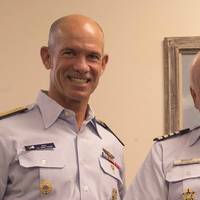Vice Commandant Visits USCG Research Center

The U.S. Coast Guard Research and Development Center (RDC) in New London, Conn. hosted the service’s new Vice Commandant – Admiral Charles Ray on Wednesday. He was onboard the Service’s research center to receive an update on several projects, including CubeSATS, UUV, Small UAS, Sunken Oil, cUAS, Artificial Intelligence, and Blue Force Tracking. Additionally, he will celebrate the growing relationship between the RDC, commissioned in 1972, and the Coast Guard Auxiliary.Admiral Ray, a 1981 graduate of the Coast Guard Academy, is the Coast Guard’s 31st Vice Commandant.
On Patrol with Cutting Edge Technology
Combat, patrol and first responder craft of all types are increasingly in need of state-of-the-art equipment to get the job done. That’s where FLIR and Raymarine come in.Raymarine products are known around the world for their rugged reliability and tactical advantage. From best-in-class sensors to integrated navigation displays, Raymarine systems enhance multi-agency interoperability for military, law enforcement and first responders. As a trusted supplier to myriad coastal and response vessels, Raymarine offers a comprehensive suite of professional tools. That mission is about to get bigger still.In April of 2017, FLIR was awarded a $50 million contract from the U.S. Coast Guard for integrated navigation electronics under the U.S.
Keeping a Watchful Eye
In 2014, Forbes Associate Director for Maritime Services at Control Risks stated that maritime risks are on the rise. Mariners and ship owner/operators experienced a 26% spike in maritime piracy and armed robbery since 2014 and the North Sea Oil Industry admitted that it had been targeted and thwarted cyber attacks, attacks that if successful could have caused untold financial and logistical damage. • Within the last decade, plans to attack a cruise ship in a major U.S. port were revealed. Maritime surveillance systems play a key role monitoring sea lanes and ports while supporting worldwide maritime safety and security. The ability to operate effectively and securely in any environment (air, land or sea) depends on an acute awareness and understanding of the surrounding elements.
Space Age Developement For Blue Force AIS

Kongsberg Seatex announced the launch of a new generation of Blue Force (BF) Automatic Identification Systems (AIS), the AIS 300BF. The unit, which supersedes the current AIS 200BF, offers outstanding secure mode abilities alongside unique AIS receiver sensitivity and robustness – refinements made possible by Kongsberg Seatex’s involvement in a number of pioneering AIS space projects. The AIS 300BF is tailor-made for vessels undertaking demanding coast guard, antipiracy, navy and boarder police operations.
RIMPAC World’s Largest International Maritime Exercise

Capt. Edward Lundquist, U.S. Navy (Ret.) talks with Vice Admiral Jerry Beaman, the commander of the U.S. THIRD Fleet, about the 2012 “Rim of the Pacific” (RIMPAC) multi-national fleet exercise. How has the Rim of the Pacific or “RIMPAC” exercised evolved to the current involvement of more than 20 nations? Our naval heritage and our tradition really began in the War of 1812. In February of 1813, the frigate USS Essex was the very first Navy ship to sail into the Pacific. Our young nation giving notice that we had as much right to the seas as anyone else.
WAVcam + Command Bridge Kept Eye on Baltimore Harbor 'Sailabration'
The electronic pairing offered safety and security personnel an unprecedented view of a 25+ square mile area of the harbor from north of Ft McHenry, west to the Hanover Street Bridge and southeast past the Francis Scott Key Bridge. With blue force tracking and the ability to correlate the video, AIS and radar tracks, first responders could see every boat in the harbor and knew its bearing and distance from the nearest fire boat or rescue vessel. "ISA is proud to have provided WAVcam's visual situation awareness technology for the Maritime Law Enforcement Information Network during Maryland's Star-Spangled Sailabration. We were honored by the invitation to work with The Mariner Group and add WAVcam's unique wide-area…







